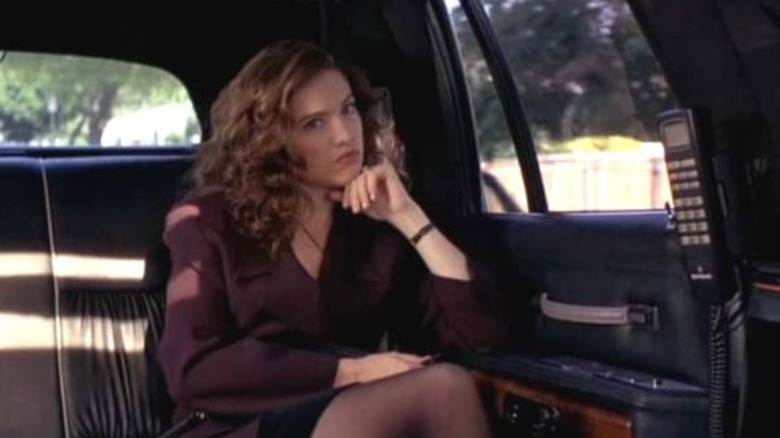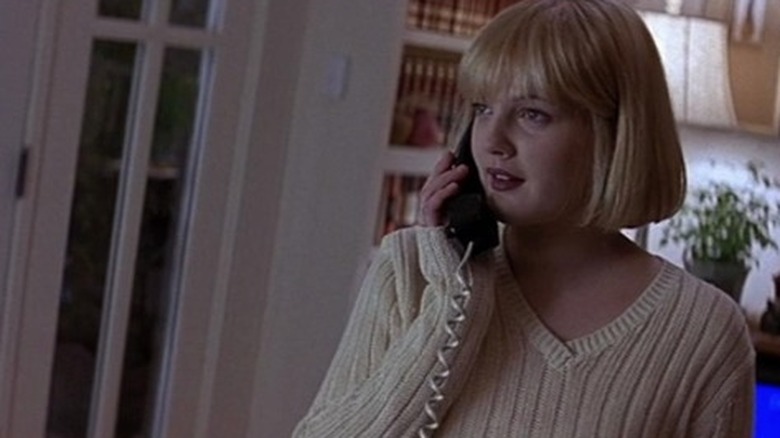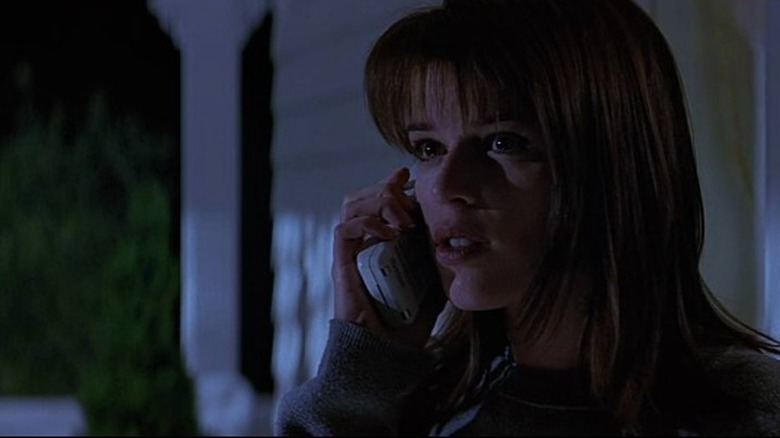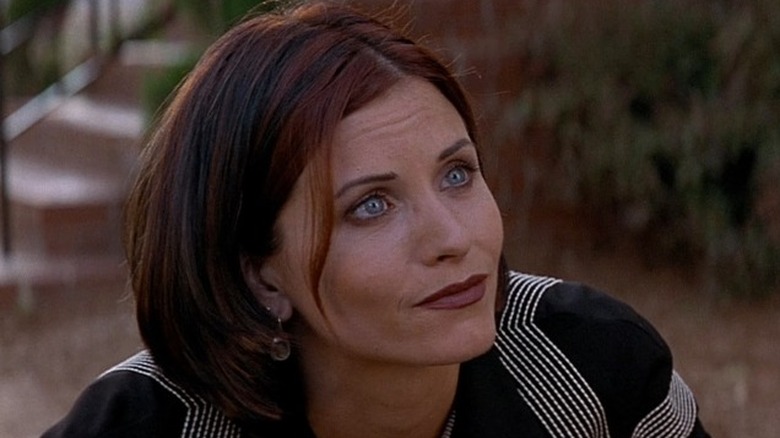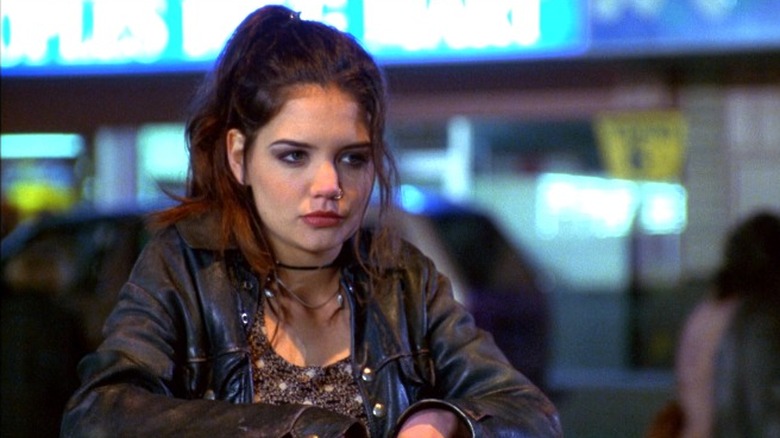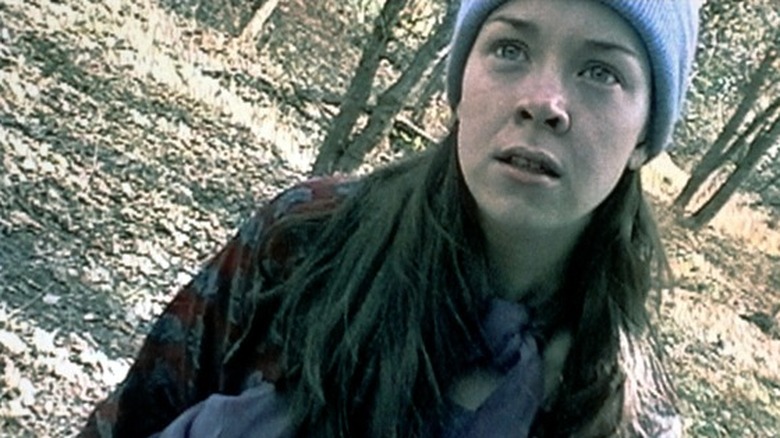'90s Scream Queens That Kept The Horror Movie Genre Alive
Horror films in the '90s have a dubious reputation. Depending on who you ask — and often how old they are — the last decade of the 20th century is either a wasteland filled with one or two terrifying films or the years when they fell in love with scary movies. The '70s and '80s dominated horror with the birth of many slasher franchises. "Friday the 13th," "Halloween," and "A Nightmare on Elm Street" gave us iconic killers, a seemingly endless number of sequels, and a new and empowering archetype to root for: the final girl. But horror films in the '80s mostly centered on the killers, with few final girls appearing in more than a single film series entry. Genre icon and legendary scream queen Jaime Lee Curtis started moving away from horrors in the '80s. By the '90s, the horror genre needed a change.
The decade began with unprecedented acclaim for the genre, with back-to-back Academy Award wins for actresses in horror. "The Silence of the Lambs" swept the Big Five at the Oscars — a feat that has only occurred three times in film history. But this prestigious trend didn't last. Aside from some early outliers, young starlets and final girl characters kept horror alive throughout the '90s. After a decade of male killers, 15 women picked up the torch and carried the genre into the 21st century.
Kathy Bates
The decade began with a bang and a scream queen for the ages. Rob Reiner's 1990 adaptation of Stephen King's terrifying novel "Misery" made a star of its central villain Kathy Bates, who earned an Academy Award for her performance. As a nurse who saves her favorite author from a car crash in the middle of a raging blizzard, Annie Wilkes initially seems like the perfect person to nurse Paul Sheldon (James Caan) back to health. However, Annie's mental instability soon becomes apparent, and it seems she has no plans to bring Paul to a hospital or let him go.
Bates' performance turns on a dime between hero worship and unhinged anger. Her joy at having a new Paul Sheldon book to devour is infectious, perfectly contrasting the terror of her murderous rage when she realizes her favorite character, Misery Chastain, has been killed. The scene where she "hobbles" Paul is considered one of the scariest scenes in film history.
Four years later, Bates portrayed another Stephen King character: the title character in Taylor Hackford's "Dolores Claiborne." Bates plays an aging housekeeper falsely accused of murdering her wealthy employer, who confesses to the long-ago murder of her husband. The film movingly explores female friendship and the lengths women go to support one another. These two memorable roles established Bates as one of Stephen King's best scream queens.
Winona Ryder
Winona Ryder made a name for herself in Tim Burton's quirky horror comedies "Beetlejuice" and "Edward Scissorhands." But the actress stepped into horror in the '90s as Mina Murray in Francis Ford Coppola's star-studded adaptation of "Dracula." Ryder portrays a Victorian bride who becomes drawn away from her reliable finacé Jonathan Harker (Keanu Reeves) by the mysterious Count Dracula (Gary Oldman), who believes her to be the reincarnation of his long-lost love. The blood-soaked love story is a visual feast: Coppola fills nearly every inch of the screen with gothic imagery. His film remains one of horror's most romantic films.
Ryder would later star in a monster movie of a different sort in "Alien: Resurrection," the fourth entry in the classic sci-fi franchise. Set 200 years after "Alien 3," Ripley (Sigourney Weaver) has been cloned to harvest the gestating baby within her. Ryder plays Call, a mysterious crew member determined to hijack the newborn aliens. But the diminutive pixie may have an ulterior motive. Written by Joss Whedon, the film carries the snark that defines '90s horror films. Unfortunately, this of-the-moment banter feels out of place on the futuristic ship. "Alien: Resurrection" is often ranked near the bottom of the franchise's six films. This is Ryder's only appearance in the franchise, and the film marked Weaver's final on-screen appearance as Ripley.
Virginia Madsen
One of the most beloved killers to emerge from the early '90s era of horror is Tony Todd's Candyman, a hook-handed killer who haunts the grounds of Chicago's infamous Cabrini-Green Housing Project. According to legend, Candyman can be summoned by saying his name five times in the mirror and then turning out the light. Those brave enough to complete the task will see him appear behind them, and his bloody hook will kill them. Virginia Madsen (Virginia Madsen) is the film's final girl, a grad student writing a thesis on urban legends, who summons Candyman. She quickly becomes entranced by the sympathetic villain and finds herself framed for Candyman's crimes.
"Candyman" has a complicated legacy and has since been reevaluated through the lens of white feminism and privilege. Despite its compassionate representation of the Cabrini-Green residents, many take issue with Helen's savior arc and cavalier attitude around entering a community without permission to study its members. Nia DaCosta's 2021 sequel reclaims Candyman for the oppressed community he represents.
Madsen's portrayal of Helen is her most notable role of the decade. However, she appeared in two more horror films before the turn of the century. In "The Prophecy," Madsen joins Elias Koteas and Christopher Walken as an elementary school teacher caught in a war between the angels. In Jan de Bont's effects-heavy remake of "The Haunting," she portrays Nell's (Lili Taylor) domineering sister, Jane.
Heather Langenkamp
Heather Langenkamp is one of the most beloved Scream Queens of the '80s. Her breakout role came in "A Nightmare on Elm Street," Wes Craven's imaginative slasher about a child murderer named Freddy Krueger who hunts the teens of Elm Street and kills them in their dreams. Langenkamp is Nancy, the film's final girl who inspired generations of fans with her refusal to give Freddy the power of her fear. She also appears in the fan favorite "A Nightmare on Elm Street 3: Dream Warriors," helping a new generation of teens battle Freddy with their collective strength.
Ten years after starring in the original film, Langenkamp returned to Elm Street in "Wes Craven's New Nightmare," a precursor to the meta-horror films that would dominate the rest of the decade. Langenkamp plays herself, the famed actress from the Nightmare on Elm Street franchise who winds up hunted in reality by the fictional killer she fought on screen. "Nightmare on Elm Street" co-stars John Saxon and Robert Englund portray themselves in the film — even Craven has a cameo! Jaime Lee Curtis would make a similar return in the 1998 film "Halloween H20: 20 Years Later" and again in David Gordon Green's "Halloween" trilogy. But Langenkamp is arguably the first returning final girl to headline a horror film.
Natasha Henstridge
When most think of horror movie monsters, they picture hairy wolfmen, demonic clowns, or tentacled aliens dripping with goo. They don't expect an alien to look like supermodel Natasha Henstridge. In "Species," Henstridge is an alien/human hybrid called Sil: the result of a scientific experiment to splice human cells with alien DNA. Raised in a lab, Sil is a beautiful woman with superhuman strength. She uses her power to escape her glass cell and destroy anyone in her way. Sil reaches adulthood at an astonishing speed and soon begins to hunt for a suitable mate. The film follows a group of scientists who try to track her down before she can spawn a life force that may destroy the human race.
Henstridge returns in "Species II" as Eve, a docile clone of Sil. Eve was designed to be studied but finds that her services are needed when a male astronaut becomes infected with the alien DNA on a trip to Mars. Both films serve as hokey and gory sci-fiction horror fun while commenting on female sexuality and gender norms. Henstridge would return to the franchise one more time in 2004, but her most successful outing as the gorgeous alien remains in the original film. The franchise suffers from dated understandings of gender essentialism, but "Species" and "Species II" stand out as interesting landmarks in feminist horror.
Drew Barrymore
Drew Barrymore has been a scream queen practically since birth. She first won attention with her literal scream at the age of seven as the charming Gertie in Steven Spielberg's "E.T. the Extra-Terrestrial" then as the titular "Firestarter" in Mark L. Lester's adaptation of Stephen King's novel. As Barrymore entered her teenage years, her life became a different kind of horror story. In her memoir, "Little Girl Lost," Barrymore recounts her struggles with addiction and lack of parental guidance. Her role as Ivy in the psychological thriller "Poison Ivy" mirrors this turmoil. After residential treatment following a suicide attempt, she won legal emancipation from her mother and began the long road to recovery.
Barrymore is now mostly known for her roles in romantic comedies and her endearing talk show, but she holds an essential place in the horror genre. She signed on to play the lead role in Wes Craven's new film, "Scream," a meta-slasher about a serial killer who taunts his victims by quizzing them about scary movies over the phone. Rather than play the film's heroine Sidney, Barrymore fought to play Casey Becker, a student who dies in the opening scene. She sacrificed the starring role, hoping to shake audience expectations that the pretty blond would survive until the final frame. In a nod to the legendary Psycho, her early death disrupted genre norms, paving the way for a new leading lady and a revolution in the horror landscape.
If you or anyone you know is struggling with addiction issues, help is available. Visit the Substance Abuse and Mental Health Services Administration website or contact SAMHSA's National Helpline at 1-800-662-HELP (4357).
If you or anyone you know is having suicidal thoughts, please call the National Suicide Prevention Lifeline by dialing 988 or by calling 1-800-273-TALK (8255).
Neve Campbell
Before "Scream," Neve Campbell was known as Julia Salinger from "Party of Five." Moments after Casey's death, Campbell's Sidney Prescott debuted on screen. Sidney becomes the primary target of Ghostface, the masked killer who haunts the suburban town of Woodsboro, California. "Scream" represents a departure from traditional slashers, as its characters live in a world where horror movies exist and the slasher formula is ubiquitous. Its most famous scene involves film geek Randy (Jamie Kennedy) standing in front of a TV showing "Halloween" while explaining the rules of surviving a horror movie.
Sidney gives a similar speech to the killer (whom she believes to be a prank caller) when asked why she doesn't watch scary movies. "They're all the same," she says. "Some stupid killer stalking some big-breasted girl who can't act and is always running up the stairs when she should be running out the front door." Craven's scary movie would turn the genre on its head and usher in a new wave of slasher films that would dominate the rest of the decade. Campbell had a role in "The Craft" released shortly before "Scream," but her role as Sidney made her one of horror's most beloved final girls.
Campbell will not return in the upcoming Scream 6. After twenty-five years of surviving the masked killer, Sidney may finally be able to live her life in peace with her family.
Courteney Cox
Neve Campbell is not the only television star to appear in Wes Craven's game-changing meta-slasher, "Scream." Cox was known to audiences as the uptight but loveable Monica Geller on the NBC juggernaut "Friends" when she portrayed the soulless reporter and true-crime author Gale Weathers. At first, Sidney detests Gale, punching her in the face for her attempts to capitalize on her mother's murder. But Gale becomes determined to make a name for herself, reporting on a series of crimes she coins the Woodsboro Murders. As the two women survive countless attacks from different iterations of Ghostface, they become lifelong friends and sister survivors.
Though she's delightful in every appearance as Gale — "Scream 3" bangs notwithstanding — Cox's best film in the franchise is "Scream 2." Returning to investigate another masked killer, Gale reunites with uneasy ally Sidney and former flame, Deputy Dewey Riley (David Arquette), whom she fell for in the original film. Gale tugs at our heartstrings when she seemingly watches Dewey die on the other side of the soundproof glass. She also helps Sidney defeat the dual Ghostface killers. However, Gale's refusal of the spotlight and insistence on riding with Dewey to the hospital solidifies her as a beloved franchise star. Her offscreen marriage to Arquette made the on-screen pairing that much better.
Jennifer Love Hewitt
Once "Scream" became a massive hit, studio executives fell over themselves to greenlight a teen slasher they could spin into a franchise. The most popular of these attempts is "I Know What You Did Last Summer." Loosely based on the novel by Lois Duncan, the film follows Julie James and her four friends as they accidentally run over a man on the night of their high school graduation. Fearing for their futures, the teens cover up the murder by dumping the body. They agree to keep the secret and go their separate way. However, someone else witnessed the crime. (The film's title refers to a note Julie receives one year later from a mysterious stalker hellbent on making them pay.)
Penned by Kevin Williamson, who also wrote "Scream" and "Scream 2," the film is more of an earnest murder mystery than a meta-slasher. However, its witty banter, trendy characters, and lack of nudity and gore make it a quintessential '90s horror film. Hewitt starred alongside Neve Campbell in "Party of Five" when she made her horror movie debut. She reprised her role as Julie James in the film's bizarre tropical sequel, "I Still Know What You Did Last Summer." But after the original film, her status as the '90s scream queen became cemented. Who can forget her standing in the middle of the street and screaming, "WHAT ARE YOU WAITING FOR?"
Sarah Michelle Gellar
Of all the '90s scream queens on this list, few have made as much of an impact as Sarah Michelle Gellar. After years of smaller roles and commercials, Gellar smashed onto the horror scene in 1997 as the titular slayer in Joss Whedon's "Buffy the Vampire Slayer." Taking over for Kristy Swanson, who originated the role in the 1992 film of the same name, Gellar developed a character that's vulnerable and strong and still inspires generations of fearless women today.
The year also saw Gellar star in "I Know What You Did Last Summer" as Helen Shivers, Julie's best friend whose plans to become a serious actress after high school go awry in the wake of their clandestine hit and run. Her tragic but thrilling death sequence during a Fourth of July parade is the film's highlight. Gellar also appears in "Scream 2" as Cici, a film student and sorority sister who falls victim to Ghostface while alone in her sorority house — again providing one of the film's most compelling deaths. Gellar married her "I Know What You Did Last Summer" co-star Freddie Prinze Jr. and starred with him in several live-action "Scooby Doo" movies, featuring "Scream" alum Matthew Lillard. After taking a break from acting, Gellar returned as headmistress of a posh high school in the Netflix film "Do Revenge," a role that sees her symbolically pass the torch to a new generation of young starlets.
Jada Pinkett Smith
Jada Pinkett Smith was an established name in the film world, having starred in critically acclaimed films like "Menace II Society" and "Jason's Lyric," before leaping into horror with 1995's "Tales from the Crypt: Demon Knight." A horror comedy spinoff from the late-night HBO horror anthology series, the film has become a genre classic, featuring Pinkett Smith as the ex-con Jeryline, who teams up with a drifter to defend the human race against an army of demons.
Pinkett Smith's other notable horror role is in the opening of "Scream 2," which doubles as a fantastic short film. As Maureen, Pinkett Smith criticizes horror for its lack of Black leads while on a date with her boyfriend, lobbying to see a Sandra Bullock film. Instead, they see "Stab," a cinematic retelling of the Woodsboro Murders. In a packed theater filled with audience members wearing Ghostface costumes supplied by the studio, the killer hides in plain sight and kills Maureen. She wanders to the screen, begging for help before dying on stage in front of the film's title card. The audience finally realizes this isn't a publicity stunt, as the killer quietly slips out of the theater. Maureen's heartbreaking death perfectly sets the stage for a film that expertly examines its predecessor and the concept of horror sequels.
Michelle Williams
Michelle Williams is now known for her dramatic roles including four Oscar Nominations and a Primetime Emmy for "Fosse/Verdon." Gen Z remembers her as Jen Lindley, the bad girl with a heart of gold on The WB's "Dawson's Creek." But before she became a household name, Williams played a brief but pivotal role in 1990's horror. Williams starred as a young Sil in the 1995 film "Species," breaking out of the lab-prison before rapidly aging and transforming into Natasha Henstridge.
Three years later, Williams played a supporting role in "Halloween H20: 20 Years Later." The film is known as the first return to the franchise for the original final girl Laurie Strode (Jamie Lee Curtis), 20 years after her iconic performance in 1978's "Halloween." Going by Keri Tate, Laurie is the headmistress of an elite boarding school. Williams plays Molly, a student who is dating Laurie's son. Laurie's decision to turn the tables on Michael and hunt him through the deserted campus is the film's highlight. But Williams is a surprisingly effective final girl. She's the one who first notices Michael lurking around campus, and she shares the traditional classroom exposition scene with Curtis. Williams has only returned once to the horror genre in the 2010 film "Shutter Island," but her fantastic '90s performances as heroine and monster keep hope alive that she will one day return to reclaim her scream queen throne.
Rebecca Gayheart
Previously known to teen audiences as the Noxzema Girl and Dylan McKay's Ill-fated wife Toni, Rebecca Gayheart made her horror debut in a small but memorable role as ditzy sorority girl Lois in "Scream 2." She followed this up with a career highlight — portraying Brenda Bates in "Urban Legend." The slasher film follows college students plagued by a killer styling their murders after modern mythology. Brenda eventually reveals she's the killer and gives a deliciously unhinged monologue explaining her crimes to the final girl Natalie (Alicia Witt), complete with a slide show explaining her motivation and 1,000 candles. With smeared eyeliner and increasingly curly hair, Brenda became one of the best on-screen female killers.
Gayheart followed this killer role with the black comedy "Jawbreaker." A spiritual successor to "Heathers," the film follows a group of popular high school girls who accidentally kill the prom queen in a prank gone wrong. Gayheart is Julie, a mean girl who finds her conscience when the plot to cover up the murder grows more elaborate. Glasses and a newfound embrace of denim show her increasing virtue. The stacked cast includes Rose McGowan, Julie Benz, and Judy Greer as wallflower turned queen bee. Poorly received at the time, Jawbreaker shocked audiences with its biting satire and sexuality. Now it has become a cult classic and is considered way ahead of its time.
Katie Holmes
It seems that every young TV starlet was getting in on the horror game in the late '90s. The trend offered stars and studios alike bankable young actresses would draw in teen crowds who might not ordinarily go to horror films. The genre was steadily moving away from the nudity-filled '80s slasher, making it less risky for well-known TV stars hoping to break into film. During her tenure on "Dawson's Creek," Katie Holmes released two horror films at the tail end of the era.
Holmes starred in the 1998 film "Disturbing Behavior," a fun nod to "The Stepford Wives" and "Invasion of the Body Snatchers." The film follows a group of misfit teens targeted by a group of model students known as the Blue Ribbons. Holmes plays against type as bad girl Rachel Wagner whose goth look and seductive demeanor are a significant departure from the studious and conservative Joey Potter she was currently playing on "Dawson's Creek."
Holmes followed this role with "Teaching Mrs. Tingle," Kevin Williamson's directorial debut. Holmes portrays Leigh Ann Watson, a top student who will do anything to be named valedictorian. Premiering three months after the mass shooting at Columbine High School shocked the nation, audiences had no appetite for murderous teenagers. The film was a box office bomb, foreshadowing the end of the '90s teen horror era.
Heather Donahue
The final entry on this list is wildly different from anyone who comes before her. Heather Donahue was an unknown actress when she signed up for an experimental film in which she and two other actors would venture into the woods, film their material, and heavily improvise scenes. "The Blair Witch Project" is not the first found footage horror film, but its massive success and terrifying premise made it one of the most profitable films of all time.
Heather is a film student who goes on a camping expedition with her two-man tech crew to make a documentary about the Blair Witch, rumored to haunt the woods outside of Burkittsville, Maryland. As they trek further into the woods, Heather Donahue, Josh Leonard, and Mike Williams become targeted by a mysterious force as the scenery seemingly shifts around them.
Even though the film was a massive hit, the audience lambasted Donahue. As an assertive woman in an unglamorous role, she was called misogynistic names and mocked for a tear-filled monologue when she blames herself for the team's predicament. Unfortunately, this heavy criticism caused the talented actress to abandon the film industry altogether. But her performance is a landmark in feminist cinema that will go down in history as one of the bravest portrayals of all time.




